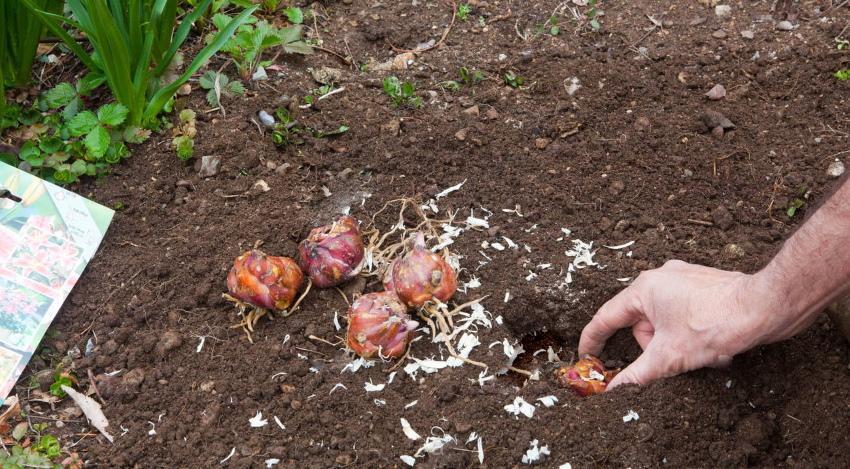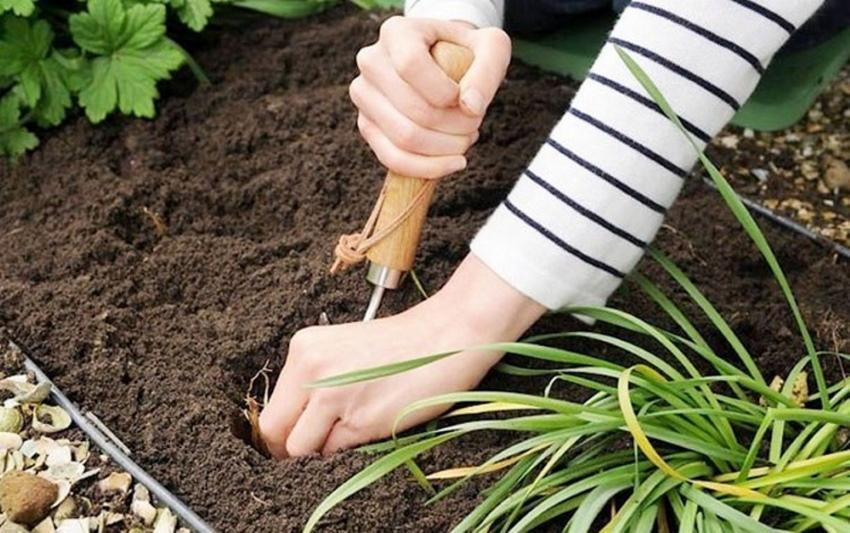Planting lilies in the fall - when and how to do it right
 Planting lilies in the fall has more advantages than disadvantages. Of course, the bulbs bought in the spring, on which sprouts have already hatched, will definitely turn out to be "alive". By the fall, the lilies retire. Their aboveground part dies off, but at the same time does not have time to start the recovery process (subject to the storage rules). Such planting material should be examined carefully to make sure that it is of high quality. But still, most gardeners prefer the autumn planting, since it brings the first flowering closer. If the plants planted in spring will bloom only next year, then "autumn" lilies - this summer. In addition, these bulbs undergo winter hardening and are less afraid of spring frosts.
Planting lilies in the fall has more advantages than disadvantages. Of course, the bulbs bought in the spring, on which sprouts have already hatched, will definitely turn out to be "alive". By the fall, the lilies retire. Their aboveground part dies off, but at the same time does not have time to start the recovery process (subject to the storage rules). Such planting material should be examined carefully to make sure that it is of high quality. But still, most gardeners prefer the autumn planting, since it brings the first flowering closer. If the plants planted in spring will bloom only next year, then "autumn" lilies - this summer. In addition, these bulbs undergo winter hardening and are less afraid of spring frosts.
Planting lilies in the fall - optimal timing

Planting too early can cause the lily to grow in warm autumn weather. This means that everything that has risen above the soil level will freeze and the flower will weaken. But it is also impossible to delay planting - in the frozen soil, the bulbs without roots will die.
Lilies take root faster in the cool, but with a plus sign. As soon as the average daily temperature drops to 10 ° C, you can safely start planting.
Depending on the region of cultivation, you can focus on the following planting dates:
- in the south - even in the middle of autumn, in October;
- in the middle lane and the Moscow region - no later than the end of September;
- in the Urals and Siberia - from the end of August to the first ten days of September.
In addition, for the timing of planting, the species of lilies is also important:
- plant bulbs of varieties with a short dormant period before everyone else, until they have time to "wake up";
- in a couple of weeks it's time for American hybrids;
- Asiatic lilies can be planted last - they are hardy.
Long-flowered, tubular and oriental lilies cannot be planted in autumn. They are more delicate, and are planted in open ground only in spring.
Where is the best place to plant lilies
 Most types of crops grow quite impressive stems. In addition, during flowering, they are weighed down by a cap of large inflorescences. Therefore, the site for lilies definitely should not be located where the wind is walking. Its impulses can break peduncles.
Most types of crops grow quite impressive stems. In addition, during flowering, they are weighed down by a cap of large inflorescences. Therefore, the site for lilies definitely should not be located where the wind is walking. Its impulses can break peduncles.
But for lighting, different varieties have different requirements:
- Plant tubular and Asiatic lilies in a well-lit area;
- take the semi-shady flower beds to oriental beauties and marchons - their flowers fade under the sun.
Do not place lilies in the same place where they grew before - change the place. Flowers grow well in beds after legumes, petunias, violets, snapdragons. But garlic, asters and strawberries are bad predecessors.
What kind of soil do lilies love
 Lilies have ambiguous requirements not only for lighting, but also for the level of acidity of the soil. Take a good look at each variety for your preferences. While some lilies need acidic soil, others need neutral acidity.
Lilies have ambiguous requirements not only for lighting, but also for the level of acidity of the soil. Take a good look at each variety for your preferences. While some lilies need acidic soil, others need neutral acidity.
But regardless of the variety, all lilies love nutritious soil, which is good for water and air. Clayy heavy soils are absolutely not suitable for them, however, as well as for other bulbous crops. They are too dense, keep moisture for a long time and dry out. And these are ideal conditions for rotting tubers.
Planting lilies in autumn requires preliminary soil preparation. Dig up the flower bed at least one month before the procedure. Otherwise, when planting in a freshly dug garden bed, the lilies will settle with the ground and go deeper. This will significantly slow down the future development and flowering process.
For lush flowering, lilies need fertile soil. Apply fertilizer while planting, providing them with nutrition for the next couple of years.
You can fertilize a flower bed with both organic matter and mineral preparations, adding under digging:
- humus;
- potassium sulfate;
- superphosphate.
If you have acidic soil and a variety that does not like it, in addition to the listed preparations, add ash.
How to choose good bulbs
 When planting lilies in the fall in the ground, use only fresh bulbs. That is, those that were dug out in the summer or just before the procedure. The planting material that is sold in stores at this time is mainly imported varieties. They are from last year, and are more suitable for spring planting. So either propagate your own flowers or only purchase from a trusted local seller.
When planting lilies in the fall in the ground, use only fresh bulbs. That is, those that were dug out in the summer or just before the procedure. The planting material that is sold in stores at this time is mainly imported varieties. They are from last year, and are more suitable for spring planting. So either propagate your own flowers or only purchase from a trusted local seller.
Good quality bulbs should be:
- solid;
- with elastic, not dry, roots;
- tight bottom;
- healthy, not rotten, covering scales;
- odorless mildew, dark wet or dry spots.
Do not rush to throw away a diseased onion of a rare variety, you can try to save it. Cut off all diseased areas, process fungicide and cover the sections with ash. When they are dry, plant such specimens in a separate bed and then observe the plants. Most often, these procedures help stop rotting, and the bulb produces a healthy plant.
Even good material needs to be pre-treated before planting. Peel dry top flakes and broken and dry roots from the bulbs. Roots that are too long (more than 5 cm) can be shortened so as not to break them. Place the lilies in the potassium permanganate solution for 30 minutes.
Planting lilies in autumn step by step
 Processed bulbs can be planted in prepared beds:
Processed bulbs can be planted in prepared beds:
- Make holes for each specimen.
- Lay a layer of expanded clay or fine gravel at the bottom - this will be drainage. He will prevent decay.
- Build an elevation in the center of the holes - plant the bulbs on it.
- Cover the lilies first with a layer of sand and then with nutritious soil, tamping it down.
- Mulch the plantings with humus from fallen leaves.
In group plantings, keep the spacing between plants, taking into account the height of the lilies. For compact varieties, 15 cm is enough, medium-sized plants need at least 25 cm.And leave a minimum of 30 cm between tall lilies.
Another important point is that you don't deeply embed the bulbs. Planting depth depends directly on the size of the bulb itself. The smaller it is, the smaller the hole should be. For almost all bulbous crops, the "triple height" rule applies. Planting depth should be equal to the height of the bulb multiplied by 3. For example, if the bulb is 5 cm tall, plant it no more than 15 cm deep.
The exception is white-flowered hybrid varieties. They can only be buried 5 cm.
Is it possible to plant a bulb with sprouts in autumn
 When and how to root dormant bulbs, we figured out. But sometimes in the growing process of lily development, a failure occurs.And instead of hibernating, they manage to give a young sprout by the fall. The reason for this is most often a violation of the storage technology of the excavated planting material. What to do with sprouted bulbs?
When and how to root dormant bulbs, we figured out. But sometimes in the growing process of lily development, a failure occurs.And instead of hibernating, they manage to give a young sprout by the fall. The reason for this is most often a violation of the storage technology of the excavated planting material. What to do with sprouted bulbs?
In this case, you have three options:
- Unscrew the sprout and plant the bulb in the flower bed. But this will have to be done a couple of weeks ahead of schedule. So the lily will have time to "switch" from forcing the stem to rooting. And she will have more time to get stronger.
- Plant the lily, as usual, but together with the sprout, without touching it. The bulb may get sick a little, but it will take root anyway. But the sprout itself will die from frost. And such a lily will give its first buds only after 2 years.
- Place the bulb in a pot and let it bloom indoors. But you will already be replanting it in open ground not in the fall, but next spring. Moreover, this is best done by transshipment, so as not to damage the roots that the flower has managed to acquire.
If you plant an awakened bulb ahead of time in August, then it may have time to bloom even this fall.
Planting and caring for lilies in the fall is a rewarding activity. You will have free time for spring work, besides, gorgeous beauties will delight you with flowering in summer. All you need is to buy healthy bulbs, find a place for them and plant them correctly. The planted lilies do not need autumn care as such. Prolonged rains will make even watering unnecessary, and fertilizer has already been applied for digging. Cover the flowerbed with mulch for the winter and that's it.